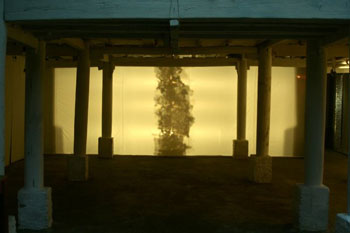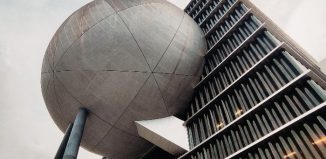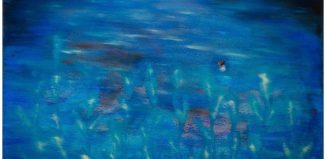KVT – at Goethe and Nha San
 Isn’t it funny how some weeks things are coincidental…
Isn’t it funny how some weeks things are coincidental…
take Blue Dragon’s Long Bien Bridge project launched at Bookworm, the Face to Face photography project by disabled persons’ from Thanh Hoa at Goethe, and Jim Elinski’s participatory project at Nha San Duc. All three are participatory projects that combine elements of visual art with a social education purpose, less so with Elinski’s Hanoi six week adventure but if you click onto his website you can see where he’s coming from.
It’s not for me to opine the first two projects. The long term effects on participants and effective use of fundees money is left to professional, appointed reviewers. I can only comment on their artistic impact on me as a viewer. I’ll leave Blue Dragon out of my sights as stuff by children, even prodigies, leaves me feeling fuzzy but hesitant to comment.
The well chosen photographs at Goethe are superb, not in any real artistic way, but because so many portray village and provincial life so very well. Foreigner and Vietnamese middle class photographers who attempt similar themes often have finished work that comes across as invasive voyeurism, but the photos at Goethe are real insights that pack a punch. Naturally a lot of the imags deal with diabled subjects and these set you back but they are poignant in their matter-of-factness and their feeling of the inevitability of suffering that is the plight of poverty. Of course the photos on show are a few of the hundreds discarded and the final installation is the work of an accomplished and perhaps professional curator…but it’s the honesty of the photos that is the star of the show. The accompanying book with photos is very good and is proving really popular with ordinary Vietnamese we show it to. Workers in the city from country villages are absorbed by its familiarities and in-your-face candidness.
(Although not my favorite photograph at Goethe, the fabulous dyptich of zebra painted ponies and the zebra-printed high heeled beauties is enormous fun!)
 Elinski’s paricipatory exhibition is also absorbing, perhaps not so much by what is on show but by the realization of the possibilities of an extended community arts or arts education program. It was good to leave photograph behind and look at other mediums….in this case the traditional use of paint on canvas to the ephemeral concept of citizens’ breaths trapped in opaque balloons. Too often similar participatory themes are pursued or headed by people whose egos dominate the process and the finished work but I feel that Elinski’s approach is one of co-operative and student centered education. As was also evident in the former projects…
Elinski’s paricipatory exhibition is also absorbing, perhaps not so much by what is on show but by the realization of the possibilities of an extended community arts or arts education program. It was good to leave photograph behind and look at other mediums….in this case the traditional use of paint on canvas to the ephemeral concept of citizens’ breaths trapped in opaque balloons. Too often similar participatory themes are pursued or headed by people whose egos dominate the process and the finished work but I feel that Elinski’s approach is one of co-operative and student centered education. As was also evident in the former projects…
![]()
| Not a reviewer, not a critic, “Kiếm Văn Tìm” is an interested, impartial and informed observer and connoisseur of the Hanoi art scene who offers highly opinionated remarks and is part of the long and venerable tradition of anonymous correspondents. Please add your thoughts in the comment field below. |














Dear Sir/madam,
As you remain an anonymous figure, I will have to address my comments to your androgynous self. I would like to commend you, first, on an overall fair review of the exhibition ‘face to face’ but I would also like to comment on a few turns-of-phrase which you employed which, I think, lessen the impact of your review and cheapen the debate somewhat.
First, your idea that the images chosen could be superb, though ‘not in any real artistic way’ I would take great exception to and I think belies some greater understanding on your part of the broad spectrum of what “art/ART” is. Perhaps you might think of Folk Art, Ignorant Art, Social Realism or many another manner or school of art of the common person. Yes, while the intention of the people taking the pictures (many for the very first time ever) was not ‘artistic’ as such, the resulting presented images rival and, perhaps, exceed any to be found by, as you say, middle-class photographers and were made from perhaps the purest artistic intention – love. Love of subject, love of the act of photographing, love of looking. How is that NOT in any ‘artistic way’?.
I take your point – that the strength and poignancy of the images lies in their uncompromising directness and honesty – but your classifying leaves out the possibility of inclusion into the larger oeuvre of creative arts/Arts and is a bit ‘class -ist’ too as a result.
Also, rather than hundreds of images being discarded, it was actually thousands that were culled to select the resulting show. But why this needs to be mentioned by you in the review I do not understand. Of course, of COURSE, images are edited by every artist, photographer, painter, sculptor before trying to present a cohesive and communicative work to a public audience. The best photographer would admit freely to this – would you mention this fact in a review of the work of a James Nachtwey or an Elliot Erwitt (for example) or the digitally processed photography of a David LaChapelle? I somehow suspect not. So why here? What is your point, sir/madam? That the work of base amateurs requires more ‘selecting’ or some related idea?
Finally, I would like to address your use of the phrase “the inevitability of suffering that is the plight of poverty”. This is something only a person looking in from the outside would say; a person clearly not suffering, clearly not poor. I found it condescending. You may not and probably do not mean it to be even if you dont agree with me that it is. But there it is. Perhaps more careful editing of your words might have benefited your meaning.
I write this to you as the curator of the exhibition. I am a “professional” curator only in the sense that I was compensated for my work in choosing the images and their presentation but it is the first time I have mounted an exhibit of other’s work. From my perspective, the show this week at the Goethe presents something rarely seen in Hanoi, or Vietnam for that matter – an interesting show of really good photography, whether by a foreign or Vietnamese photographer. I believe it is an excellent exhibit. And I believe you believe it too. I tried, as much as possible, to keep myself and my ego, as a middle-class creative person and fellow photographer, as far towards the background as possible and to give an as direct, as clear and unfiltered, as impacting experience of the lives and the act of ‘looking’ by the people whose work you see on the walls of the Goethe as possible. There is more about my thinking in my “Curator’s Note” presented in the catalog. I learned a great deal about honesty, about purity of vision, about direct looking throughout the months of looking at the many images made by these artists. I hope in the largest of ways that the smallest hint of the verity of intent of these people’s work finds its way into my own.
Thank you sir/madam. Jamie Maxtone-Graham